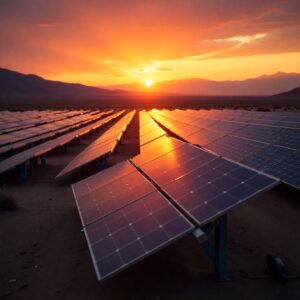Introduction
As the world grapples with the effects of climate change and seeks sustainable solutions, renewable energy has emerged as a pivotal player in the global energy landscape. This article delves into the future of renewable energy, exploring the latest trends, the challenges facing the sector, and the opportunities that lie ahead. By understanding these aspects, we can better appreciate the role of renewable energy in achieving a sustainable future.

Understanding Renewable Energy
Renewable energy refers to energy derived from natural processes that are replenished constantly. This includes sources such as solar, wind, hydroelectric, geothermal, and biomass. Unlike fossil fuels, which contribute to greenhouse gas emissions and environmental degradation, renewable energy sources offer a cleaner, more sustainable alternative.
Key Types of Renewable Energy
- Solar Energy: Harnessing sunlight through photovoltaic cells or solar thermal systems.
- Wind Energy: Utilizing wind turbines to convert wind kinetic energy into electricity.
- Hydroelectric Energy: Generating power by using water flow to turn turbines.
- Geothermal Energy: Tapping into the Earth’s internal heat for electricity and heating.
- Biomass Energy: Converting organic materials into energy through combustion or biochemical processes.
Current Trends in Renewable Energy
1. Increased Investment
Investment in renewable energy technologies has surged in recent years. According to the International Renewable Energy Agency (IRENA), global investment in renewable energy reached over $300 billion in 2020, with solar and wind energy attracting the largest shares. This trend is expected to continue as governments and private sectors recognize the economic and environmental benefits of transitioning to renewable sources.
2. Technological Advancements
Innovations in technology are driving the renewable energy sector forward. Advances in solar panel efficiency, wind turbine design, and energy storage solutions are making renewable energy more accessible and cost-effective. For instance, the development of bifacial solar panels and floating wind farms are revolutionizing how we harness energy.

3. Policy Support and Incentives
Governments worldwide are implementing policies and incentives to promote renewable energy adoption. These include tax credits, subsidies, and renewable energy standards. Countries like Germany, China, and the United States are leading the way in creating favorable regulatory environments for renewable energy investments.
4. Decentralization of Energy Production
The future of energy is shifting towards decentralization, with more individuals and communities generating their own energy through solar panels and small wind turbines. This trend not only empowers consumers but also enhances energy security and resilience.
5. Integration of Smart Technologies
The integration of smart technologies, such as the Internet of Things (IoT) and artificial intelligence (AI), is transforming the renewable energy landscape. Smart grids and energy management systems optimize energy distribution, enhance efficiency, and enable real-time monitoring of energy consumption.
Challenges Facing Renewable Energy
1. Intermittency and Reliability
One of the primary challenges of renewable energy is its intermittent nature. Solar and wind energy generation depends on weather conditions, which can lead to fluctuations in power supply. Developing reliable energy storage solutions, such as batteries and pumped hydro storage, is crucial for addressing this challenge.
2. Infrastructure Limitations
Many regions lack the infrastructure needed to support widespread renewable energy deployment. Upgrading existing power grids and building new transmission lines are essential for efficiently transporting renewable energy from generation sites to consumers.
3. Initial Costs and Financing
While the long-term benefits of renewable energy are clear, the initial costs of installation and technology can be a barrier for many. Innovative financing models, such as power purchase agreements (PPAs) and community solar programs, are emerging to help alleviate these costs and promote accessibility.

4. Environmental and Social Concerns
Despite its benefits, renewable energy projects can raise environmental and social concerns. For example, large-scale solar farms may impact local ecosystems, while wind farms may face opposition from communities due to noise or aesthetic issues. Engaging stakeholders and conducting thorough environmental assessments are essential for addressing these concerns.
5. Market Competition
As renewable energy technologies advance, competition among various energy sources intensifies. Fossil fuels, despite their environmental drawbacks, continue to dominate in many regions due to established infrastructure and lower short-term costs. Transitioning to renewable energy requires overcoming these market dynamics.
Opportunities in Renewable Energy
1. Job Creation
The renewable energy sector is a significant source of job creation. According to the IRENA, the renewable energy industry employed over 11 million people globally in 2018, with numbers expected to grow as investments increase. Jobs range from manufacturing and installation to research and development.
2. Energy Independence
Investing in renewable energy enhances energy independence for countries reliant on imported fossil fuels. By harnessing domestic energy resources, nations can reduce their vulnerability to geopolitical tensions and fluctuations in global energy markets.
3. Technological Innovation
The renewable energy sector is a hotbed for technological innovation. Companies are continually developing new solutions to improve efficiency, reduce costs, and enhance sustainability. This innovation not only benefits the energy sector but also has positive spillover effects on other industries.
4. Climate Change Mitigation
Transitioning to renewable energy is critical for mitigating climate change. By reducing greenhouse gas emissions, renewable energy can help limit global warming and its associated impacts, such as extreme weather events and rising sea levels.

5. Improved Public Health
Renewable energy sources contribute to better air and water quality by reducing pollution from fossil fuels. This improvement in public health can lead to lower healthcare costs and enhanced quality of life for communities.
FAQs
What is renewable energy?
Renewable energy is energy derived from natural processes that are continuously replenished, such as solar, wind, hydroelectric, geothermal, and biomass energy.
Why is renewable energy important?
Renewable energy is essential for reducing greenhouse gas emissions, combating climate change, and promoting energy independence and sustainability.
What are the main types of renewable energy?
The main types of renewable energy include solar energy, wind energy, hydroelectric energy, geothermal energy, and biomass energy.
What challenges does renewable energy face?
Challenges include intermittency and reliability, infrastructure limitations, initial costs, environmental and social concerns, and market competition from fossil fuels.
How can I invest in renewable energy?
Individuals can invest in renewable energy through direct investments in solar panels, community solar programs, or by purchasing stocks in renewable energy companies.
Conclusion
The future of renewable energy is bright, with numerous trends, challenges, and opportunities shaping its landscape. As we transition towards a more sustainable energy system, it is crucial to embrace renewable energy solutions that promote environmental stewardship, economic growth, and social equity. By understanding and addressing the challenges while capitalizing on the opportunities, we can pave the way for a cleaner, greener future powered by renewable energy.


1 thought on “The Future of Renewable Energy: Trends, Challenges, and Opportunities”